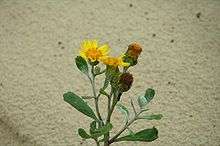Senecio crassiflorus
Senecio crassiflorus, one of the native South American Senecio and an herbaceous dune dwelling perennial.[4][5]
| Senecio crassiflorus | |
|---|---|
 | |
| Margarida das dunas | |
| Scientific classification | |
| Kingdom: | Plantae |
| Clade: | Tracheophytes |
| Clade: | Angiosperms |
| Clade: | Eudicots |
| Clade: | Asterids |
| Order: | Asterales |
| Family: | Asteraceae |
| Genus: | Senecio |
| Species: | S. crassiflorus |
| Binomial name | |
| Senecio crassiflorus | |
| Synonyms | |
|
Cineraria crassiflora Poir.[1] | |
Common name
Portuguese: margarida-das-dunas[5]
Description
Senecio crassiflorus is not an upright herb, the silvery to white woolly 20 centimetres (7.9 in) to 50 centimetres (20 in) tall plant tends to "lay down and rest" on the dunes and sandy coastal areas it inhabits.
- Leaves
- Shaped like spatula with roundish, long, narrow, linear bases to having a broad rounded apex and a tapering base. Mostly 4 centimetres (1.6 in) to 8 centimetres (3.1 in) long, .6 centimetres (0.24 in) to 2 centimetres (0.79 in) wide. The edges are smooth or toothed towards apex and both surfaces woolly.
- Flowers
- Broadly bell shaped, woolly flower heads appear singly or a few together, 1 centimetre (0.39 in) to 1.5 centimetres (0.59 in) in diameter.
- Seeds and reproduction
- Achenes .3 centimetres (0.12 in) to .5 centimetres (0.20 in); pappus 1.5 centimetres (0.59 in) long.[6]
- Reports claim S. crassiflorus does not produce viable seeds and spreads itself asexually or via vegetative reproduction.[5][7]
- Community species
-
- Ipomoea pes-caprae
- Hydrocotyle bonariensis
- Juncus acutus[5]
- Panicum sabularum
- Spartina cf. ciliata
- Hydrocotyle umbellata[8]
- Colombian communities: In a remote sensing project for rapid ecological evaluation, S. crassiflorus was found in Colombia inhabiting two areas that were evaluated.
- A flood prone coastal region:
- Acanthospermum australe, Acicarpha tribuloides, Ambrosia tenuifolia, Androtrichium trigynum, Azolla sp., Bacopa monnieri, Baccharis articulata, Cardionema ramosissima, Centella asiatica, Cephalanthus glabratus, Chenopodium retusum, Cuphea carthagenensis, Cynodon dactylon, Cyperus haspan, Cyperus virens, Enydra sessilis, Erechtites hieracifolia, Eryngium pandanifolium, Hedyotis salzmanii, Ischaemum minus, Juncus microcephalus, Nymphoides indica, Panicum racemosum, Paspalum nicorae, Petunia litoralis, Pluchea sagitalis, Polygonum punctatum, Pterocaulon sp., Ranunculus apiifolius,Sesbania punicea, Solanum platense, Thelipteris interrupta, Xyris jupicai and Zizaniopsis bonariensis.
- A flood prone coastal region:
- A sandy area near to a forest:
- Acanthospermun australe, Baccharis arenaria, Cynodon dactylon, Fragmites communis, Hydrocotyle bonariensis, Mikania micrantha, Myrcianthes cisplatensis, Oenothera sp., Passiflora caerulea, Polygonum sp., Salyx hunboldtiana, Sapium glandulosum, Schoenoplectus californicus, Sebastiania schottiana, Sesbania punicea, Theliptheris interrupta and Tillandsia aeranthos.[9]
- A sandy area near to a forest:
Distribution
- Native
- Neotropic:
- Current
- Neotropic:
- Australasia:
- Australia: New South Wales[6]
- New Zealand North: Wellington[10]
gollark: Why would you want *that*?
gollark: NoooooOO! I missed an AP nebula!
gollark: Yay, an AP hatchling and I got it!
gollark: I don't know which spriters have which alts, and some may not want to be bothered.
gollark: Well, probably, it's a chicken with a slightly rude code.
References
- Tropicos. "Senecio crassiflorus (Poir.) DC". Missouri Botanical Garden. Retrieved 2008-04-23.
- Australian National Botanic Gardens. "Senecio crassiflorus (Lam.) DC". Australian Plant Name Index. Centre for Plant Biodiversity Research. Retrieved 2008-04-23.
- Martius, Karl Friedrich Philipp von; Eichler, August Wilhelm; Endlicher, István László; Fenzl, Eduard; Mary, Benj; Oldenburg, R; Urban, Ignaz (1840–1906). "Botanicus.org: Flora Brasiliensis, enumeratio plantarum in Brasilia hactenus detectarum". Monachii et Lipsiae [Munich & Leipzig] : R. Oldenbourg ; 1840-1906. Retrieved 2008-04-24.
- "Senecio crassiflorus". Germplasm Resources Information Network (GRIN). Agricultural Research Service (ARS), United States Department of Agriculture (USDA). Retrieved 2008-04-23.
- Klein, Alecsandro Schardosim; Vanilde Citadini-Zanette; Robson Santos (September 2007). "Florística e estrutura comunitária de restinga herbácea no município de Araranguá, Santa Catarina" (PDF). Biotemas (in Spanish). 20 (3): 15–26. – 1643. Retrieved 2008-04-25.
- National Herbarium of New South Wales. "Senecio crassiflorus (Poir.) DC". New South Wales FloraOnline. Royal Botanic Gardens, Sydney. Retrieved 2008-04-23.
- "Scientific name : Senecio crassiflorus (Poir.) DC". Exotic Plant Life and Weeds. New Zealand Plant Conservation Network. Retrieved 2015-01-27.
- Bujes, C. S.; Verrastro, L. (August 31, 2006). "Thermal biology of Liolaemus occipitalis (Squamata, Tropiduridae) in the coastal sand dunes of Rio Grande do Sul, Brazil". Brazilian Journal of Biology. 66 (3): 945–54. doi:10.1590/S1519-69842006000500021. PMID 17119843.
- Berlinc, Christian Niel; Rosario Beyhaut; Eduardo Marchisi; Nestor Pérez; Gonzalo Picasso; Carlos Prigioni; José Manuel Venzal (17–23 October 2004). "RAPID ECOLOGICAL EVALUATION FOR THE PROJECT ON THE USE OF REMOTE SENSING TECHNOLOGIES FOR ECOSYSTEM MANAGEMENT TREATIES" (PDF). Remote Sensing Technologies for Ecosystem Management Treaties. Bureau of Oceans and International Environmental and Scientific Affairs and United States Department of State. Retrieved 2008-04-25.
- Webb, C.J. (October 1987). "Checklist of dicotyledons naturalised in New Zealand 18. Asteraceae (Compositae) subfamily Asteroideae". New Zealand Journal of Botany. 25 (4): 489–501. doi:10.1080/0028825x.1987.10410081.
External links
![]()
![]()
- "Cultivated Senecio crassiflorus". Tony. 2003-10-12. Retrieved 2008-04-25. External link in
|publisher=(help) - Landcare Research. "Ngā Tipu o Aotearoa - New Zealand Plants". New Zealand Plant Names Database. Landcare Research Allan Herbarium and New Zealand Plant Names Database. Retrieved 2008-04-25.
This article is issued from Wikipedia. The text is licensed under Creative Commons - Attribution - Sharealike. Additional terms may apply for the media files.